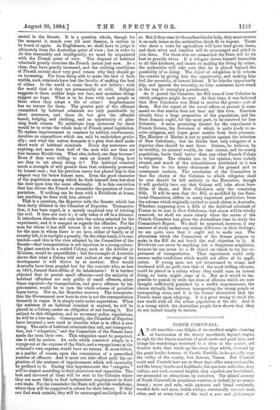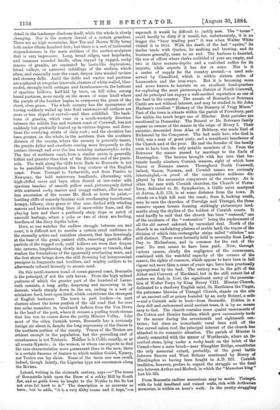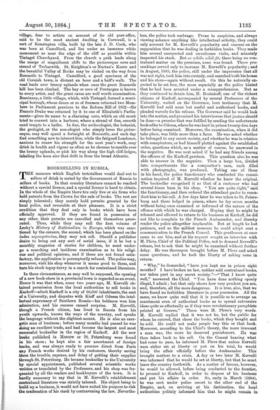NORTH CORNWALL.
AN old traveller—one Gilpin, if we recollect aright—hearing at Launceston of the dreary moorlands beyond, begins to sigh for the Saxon comforts of good roads and good inns, and brings his wanderings westward to a close at the quaint, old • frontier town that winds up the steep slope which, crowned by the great border fortress of Castle Terrible, looks proudly over the valley of the scanty, but famous, Tamar. But Cornish roads and Cornish inns are in these days alike unexceptionable, and the breezy heaths and highlands, the spacious solitudes, deep valleys, and rock-crowned heights that repelled our forefathers, are accounted as attractions by ourselves. The inland scenery of North Cornwall, in propitious weather, is indeed, by no means dreary ; moor and vale, wide pastures and broad cornlands, wooded dells and open, fertile valleys, continually succeed each other, and at every turn of the road a new and picturesque
detail in the landscape discloses itself, while the whole is slowly changing. Nor is the scenery devoid of a certain grandeur.
There are no high mountains, Row Tor and Brown Willy being both under fifteen hundred feet ; but there is a sort of horizontal stupendousness in the main outlines of the surface-sculpture that is very impressive. Long, broad ridges, vast hogsbacks, and immense rounded knolls, often topped by rugged, rocky masses of granite, are separated by basin-like depressions, broad valleys, or narrower infoldings of the surface, which often, and especially near the coast, deepen into wooded ravines and streamy dells. Amid the fields and wastes and pastures are scattered at irregular intervals, clusters of white-walled, blue- roofed, strongly-built cottages and farmhouses—in the bottoms of spacious hollows, half-hid by trees, on hill sides, among broad pastures, more rarely on the crown of some knoll where the purple of the heather begins to overpower the green of the short, close grass. The whole country has the appearance of having suddenly welled up into fluid existence—all surfaces are more or less sloped or curved—and then solidified. The back- bone of granite, which runs in a south-westerly direction between the middle line and western coast of Cornwall, has not suddenly but gradually heaved up in various degrees and direc- tions the overlying strata of slaty rock ; and the elevation has been greater, on the whole, in the northern than the southern division of the county, where the scenery is generally tamer, the granite dykes and overflows coming more frequently to the surface through and over the less resisting metamorphic rocks. The line of northern coast, from a similar cause, is generally loftier and grander than that of the Belerion end of the penin- sula. The walk along the cliffs from Bude to Boscastle is not to be paralleled throughout the long contour of the English coast. From Tintagel to Trebarwith, and from Pentire to Newqnay, the bold waterworn headlands, alternating with, high-cliffed coves and bays, often floored at low-water with spacious beaches of smooth yellow sand, picturesquely dotted with scattered rocky masses and craggy outliers, offer an end- less succession of the scenes Mr. Hook so loves to paint,— beetling cliffs of coarsely-laminar rock overhanging tumultuous, humpy, billowy, clear green or blue seas, flecked with whirling masses and broken circling lines of snow-white foam, and dis- playing here and there a perilously steep slope or patch of emerald herbage, where a yoke or two of sheep are feeding, heedless of the dizzy depths below.
Here, as one watches the endless struggle between sea and coast, it is difficult not to ascribe a certain cruel craftiness to the eternally active and resistless element, that laps fawningly at the base of the great, patient cliffs, removing particle after particle of the rugged rock, until hollows are worn that deepen into caverns, lengthening slowly into passages or tunnels, that weaken the foundations of the apparently everlasting mass, and the first storm brings down the still frowning but honeycombed precipice in fragments and boulders, and mighty outliers to be afterwards reduced leisurely to atomic sand.
On this north-western trend of ocean-gnawed coast, Boscastle is the principal, if not the only haven. From the high upland pastures of which the greater part of the hundred of Lesne- weth consists, a long gully, deepening and narrowing in its descent, winds steeply down to the sea, ending in a sort of miniature fiord, bent upon itself, which constitutes the strangest of English harbours. The town in part borders—in part clusters about the lower portion of the old road that for over two miles meanders in breakneck fashion from the Ven Down to the head of the port, where it crosses a purling trout-stream that has run its course down the pretty Minster Valley. Like most of the olden Cornish towns, Boscastle has a curiously foreign air about it, despite the long supremacy of the Saxon in the northern portion of the county. Traces of the Teuton are evident enough in the population, but the prevailing cast of countenance is not Teutonic. Neither is it Celtic exactly, or at all events Kymric ; in the women, in whom one expects to find the race-characteristics more permanent than in the men, there is a certain fineness of feature to which neither Goidel, Kymry, nor Teuton can lay claim. Some of the faces one sees recall, indeed, though faintly, the Ligurian type not uncommon along the Riviera.
Leland, writing in the sixteenth century, says :—" The tonne of Boscastelle lyith upon the Brow of a rokky Hill by South Est, and so goith down by lenght to the Northe to the Se but not even tel hard to it." The description is as accurate as terse; but he adds, "it is a very filthy tonne and it kept,"—a
reproach it would be difficult to justify now. The " tonne ". could hardly be dirty if it would, for, unfortunately, it is no longer the "busy trading port" it was when Walter White visited it in 1854. With the death of the last " squire," its timber trade with Quebec, its malting and brewing, and its business generally, came to an end. The harbour is deserted, the row of offices where clerks scribbled of yore are empty, and two or three manure-depots and a coal-shed suffice for its imports, while exports it has few or none. Nor is it a centre of supply for the country around,—a need sub- served by Camelford, which is within sixteen miles of Launceston and the iron-ways. But it is becoming more and more known to tourists as an excellent bead-quarters for exploring the most picturesque district of North Cornwall, and its principal inn enjoys a well-merited reputation as one of
the beet in the country. The annals of Boscastle or Botreaux Castle are not without interest, and may be studied in Sir John Maclean's excellent " History of the Deanery of Trigg Minor." Part of the town is situate within the parish of Forrabury, part lies within the much larger one of Minster. Both parishes are mentioned in Domesday. The Boterel or De Botreaux family appear as owners of the manor in the reign of Henry L Their ancestor, descended from Alan of Brittany, was made Earl of Richmond by the Conqueror. The last male heir, who died in 1462, was a man of great piety, and a munificent benefactor of the Church and of the poor. He and the founder of the family seem to have been the only notable members of it. From the Botreaux the manor passed by marriage to the Earls of Huntingdon. The heiress brought with her into that for- tunate family nineteen Cornish manors, eight of which bore Saxon or Norman names. Throughout North Cornwall, indeed, Saxon, Norman, and Cornish names are curiously intermingled,—a proof of the comparative mildness dis- played by the successive conquerors of the country. As is often the case with Cornish churches, the Church of Forra- bury, dedicated to St. Symphorian, a Gallic saint martyred at Autun, A.D. 178, is at some distance from the town. It stands on a high hill near the coast; from it, looking south,, may be seen the churches of Trevalga and Tintagel, the three massive square towers forming strikingly picturesque land- marks along the skyline of the boldest of Cornish coasts. It need hardly be said that the church has been " restored," one of the incidents of the " restoration " being the replacement of all the old carved oakwork by varnished deal. North of the church is an undulating plateau of arable land, the traces of the division of which into rectangular strips called " stitches " are still distinct. These were formerly held in severalty from Lady- Day to Michaelmas, and in common for the rest of the year. No rent seems to have been paid. Now, through various causes, chiefly the negligence of the commoners, combined with the watchful rapacity of the owners of the manor; the rights of common, which appear to have been in full vigour not more than a score of years ago, have been practically appropriated by the lord. The rectory was in the gift of the Abbot and Convent of Hartland, but in the still extant list of rectors we find, in 1544, the significant entry of the presenta- tion of Walter Perys by King Henry VIII. Minster Church, dedicated to a shadowy English saint, St. Merthiana the Virgin, the patroness likewise of Tintagel Church, stands on the site of an ancient cell or priory founded by an early Boterel, a mile —and a Cornish mile to boot—from Boscastle. Hidden in a deep dell and embosomed amid. ancient trees, it is by no means easy to find. The church contains some quaint monuments of the Cotton and Hender families, which gave successively lords to the manor during the seventeenth and eighteenth cen- turies ; but since an iconoclastic rural dean sold off the fine carved oaken roof, the principal interest of the church has attached to its romantic situation. The parish of Minster is closely connected with the manor of Worthevale, where an in- scribed stone, lying under a rocky bank on the brink of the Camel—here a mere brook—near Slaughter Bridge, constitutes the only memorial extant, probably, of the great battle between Saxons and West Britons mentioned by Henry of Huntingdon as having been fought in A.D. 823. Cornish tradition, however, prefers to regard the struggle as the final one between Arthur and Modred, in which the "blameless king " lost his life.
From Boscastle endless excursions may be made. Tintagel, with its bold headland and ruined walls, rich with Arthurian memories, is within an hour's walk.' In the pretty straggling village, dear to artists on account of its old post-office, said to be the most ancient dwelling in Cornwall, is a sort of Kensington villa, built by the late J. D. Cook, who was born at Camelford, and lies under an immense white monument as near the edge of the cliff as possible within Tintagel Churchyard. From the church a path leads along the 'merge of magnificent cliffs to the picturesque cove and strand of Trebarwith. St. Knighton's or Nectan's Keeve and the beautiful Valley of Rocks may be visited on the way from Boscastle to Tintagel. Camelford, a good specimen of the old Cornish town, is distant an hour and a half's walk. The road leads over breezy uplands when once the great Boseastle hill has been climbed. The bay or cove of Pentargan is known to every artist, and the great caves are well worth examination. Bossinney, a little village, which, with Tintagel, formed a muni- cipal borough, whose dozen or so of freemen returned two Mem- bers to Parliament previous to the Reform Bill of 1832—Sir Francis Drake was returned by it to one of Elizabeth's Parlia- ments—gives its name to a charming cove, which an old monk tried to convert into a harbour, where a strand of fine, smooth sand tempts to a bathe. In fine, the archaeologist, the botanist, the geologist, or the non-ologist who simply loves the pictur- esque, may well spend a fortnight at Boscastle, and each day find something new to interest him, while the fatigued Londoner, anxious to renew his strength for the next year's work, may drink in health and vigour as often as he chooses to ramble over the breezy uplands, or pick his way along the high cliff-ledges, inhaling the keen airs that drift in from the broad Atlantic.




































 Previous page
Previous page